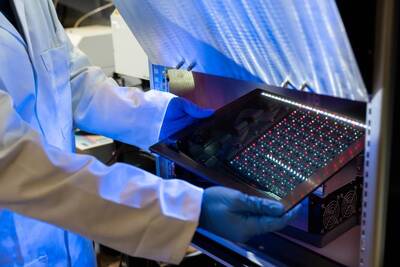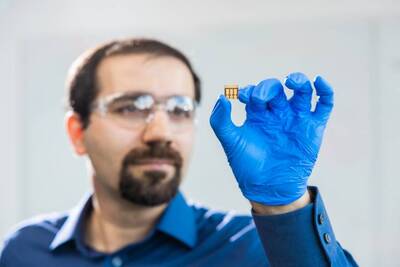Novel solar cells power devices from indoor light

An international team led by researchers from University College London has developed durable new solar cells capable of efficiently harvesting energy from indoor light, meaning devices such as keyboards, remote controls, alarms and sensors could soon be battery free.
The team used a material called perovskite, which is increasingly used in outdoor solar panels and, unlike traditional silicon-based solar panels, has potential to be used indoors as well, as its composition can be adjusted to better absorb the specific wavelengths of indoor light.
A major drawback of perovskite, however, is that it contains tiny defects in its crystal structure — known as ‘traps’ — which can cause electrons to get stuck before their energy can be harnessed. These defects not only interrupt the flow of electricity but also contribute to the material’s degradation over time.
In a study published in the journal Advanced Functional Materials, the team describes how they used a combination of chemicals to reduce these defects, potentially making perovskite indoor solar panels viable.
The perovskite photovoltaics they engineered, the team say, are about six times more efficient than the best commercially available indoor solar cells. They are more durable than other perovskite devices and could be used for an estimated five years or more, rather than just a few weeks or months.
Senior author Dr Mojtaba Abdi Jalebi, Associate Professor at the UCL Institute for Materials Discovery, said: “Billions of devices that require small amounts of energy rely on battery replacements — an unsustainable practice. This number will grow as the Internet of Things expands. Currently, solar cells capturing energy from indoor light are expensive and inefficient. Our specially engineered perovskite indoor solar cell can harvest much more energy than commercial cells and is more durable than other prototypes. It paves the way for electronics powered by the ambient light already present in our lives.
“We are currently in discussions with industry partners to explore scale-up strategies and commercial deployment. The advantage of perovskite solar cells in particular is that they are low-cost — they use materials that are abundant on Earth and require only simple processing. They can be printed in the same way as a newspaper.”
One problem in earlier perovskite solar cells was the presence of a high density of traps in the material and its interfaces with charge collecting layers, which disrupted the flow of charge and caused energy to be lost as heat.
The research team introduced a chemical (rubidium chloride) that encouraged a more homogeneous growth of perovskite crystals with minimal strains, reducing the density of these traps.
Two other chemicals — organic ammonium salts N,N-dimethyloctylammonium iodide (DMOAI) and phenethylammonium chloride (PEACl) — were added to stabilise two types of ions (iodide and bromide ions), preventing them from migrating apart and bunching into different phases, which degrades the performance of the solar cell over time, again by disrupting the flow of charge through the material.
Lead author Siming Huang, a PhD student at UCL’s Institute for Materials Discovery, said: “The solar cell with these tiny defects is like a cake cut into pieces. Through a combination of strategies, we have put this cake back together again, allowing the charge to pass through it more easily. The three ingredients we added had a synergistic effect, producing a combined effect greater than the sum of the parts.”
The team found that their solar cells converted 37.6% of indoor light (at 1000 lux — equivalent to a well-lit office) into electricity, a record for this type of solar cell optimised for indoor light, that is with a bandgap of 1.75 eV (electron volts).
The researchers also tested the solar cells to see how well they resisted degradation over time.
After more than 100 days, the newly engineered cells retained 92% of their performance, compared to a control device (perovskite whose flaws had not been reduced) that retained only 76% of its initial performance.
In a harsh test of 300 hours of continuous intense light at 55°C, the new solar cells retained 76% of their performance, while the control device dropped to 47%.
The team involved researchers from the UK, China and Switzerland.
Soft robot uses magnetic fields to power itself autonomously
Inspired by the movement of manta rays, researchers have developed a small, magnetically powered...
Perovskite 'energy sandwich' could power next-gen solar
Researchers have achieved a new level of control over the atomic structure of halide perovskites,...
Creating the truck of tomorrow
Exploring the technological innovations, infrastructure solutions and emerging delivery methods...






